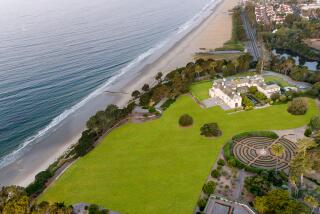Old Homes Still House City History
SANTA BARBARA — For Horatio Gates Trussell, it was love at first sight.
After making the long and lonely Boston-California run via Cape Horn, the sea captain from Maine was strolling along the beach in Santa Barbara when he saw a young girl, Ramona Burke.
The 42-year-old seaman waited until Ramona reached her 16th birthday in 1851, then they were married at Mission Santa Barbara.
He built his bride a home, using adobe brick and timbers salvaged from the side-wheeler Winfield Scott, which went aground on Anacapa Island.
The Trussells’ 135-year-old house still stands and has been designated a California Historical Landmark. Also, it is one of only two vintage homes in Santa Barbara that have been restored and opened to the public.
The other is next door, a fancier place built in 1862, and known as the Fernald House. The multigabled mansion was moved from its original site after the last surviving child of Judge and Mrs. Charles Fernald died at the age of 92.
Both properties were bequeathed to the Santa Barbara Historical Society. Members have restored the original and other period furnishings so visitors can see what family life was like in early Santa Barbara.
The homes are behind a white picket fence at 412 and 414 W. Montecito St. The adobe is shaded by enormous cork oak trees, reportedly offshoots of acorns Capt. Trussell brought on a voyage from the East Coast.
The home’s architecture reflects the owner’s down-east roots. Its shingled roof and clapboard siding are more representative of New England than Southern California, but the thickness of the door jambs reveals typical adobe brick construction behind the facade. The floorboards are from the wreck of the coastal steamer.
Among the furnishings are Trussell’s sea chest and a music box. Visitors also can see medical books and a doctor’s diploma that belonged to later owners of the house, which is officially called the Trussell-Winchester Adobe.
The second name refers to the family of Sara Winchester, a local schoolteacher who lived in the home after her parents bought it in 1882. Her brother was a physician who built the adjoining carriage house, where he lived after divorcing his wife because of her “verbal abuse.”
True love between husband and wife is more evident in the ornate house behind the adobe. In the vestibule is a stained-glass window that was a present from Judge Fernald to his wife on their first wedding anniversary in 1864.
The mix of Gothic Revival, Eastlake and Queen Anne styles is traced to a remodeling of the Fernald House to 14 rooms to accommodate the family’s four children. A local cabinetmaker crafted the redwood staircase, wainscoting and other decorations.
Furniture, paintings, clothes, clocks, books and even a diary are among the original family possessions still in the house.
Visitors also can see the piano of one of the children, Florence, who later taught music at home. Photos from the family album are displayed in the hallway.
Guests are welcome on Sundays from 2 to 4 p.m., when docents give half-hour guided tours at each home. A donation is requested.
While in the neighborhood, you can investigate bygone types of transportation in the Old Spanish Days Carriage Museum. It’s a block away at 129 Castillo St. on the northwest end of Pershing Park.
Visitors can wander among an unusual collection of 75 carriages, coaches, carts and wagons.
During Santa Barbara’s annual Old Spanish Days Fiesta in August, horses will be hitched up to a dozen or so of the carriages that will appear in the fiesta parade. Otherwise, the public can only view the historical vehicles at the museum on Sundays from 2 to 4 p.m. Admission is free but donations are appreciated.
Near the entrance is a hand-carved and brightly painted ceremonial wine cart from Sicily. The 17th-Century cart was used by guests at Hearst Castle at San Simeon.
Nearby is a handsome black buggy that cost $31.85 when it was built in the early 1900s. For $15 more, it could be equipped with rubber tires. You’ll see black surreys and hansom cabs, too.
Look for one of the largest public coaches in California, an 18-passenger “mud-wagon” vehicle without windows or doors that ran from San Luis Obispo to Ventura. Its last trip was over the San Marcos Pass in 1902.
Also on display are pioneer Conestoga wagons, early Army wagons, U.S. mail stages and a century-old police paddy wagon. An eye-catcher is the 1884 fire engine from Hyde Park, N.Y., that saw service in Los Angeles.
Take in the mid-1800s funeral wagon, which is complete with coffins, a Studebaker surrey made of wicker and the red-and-yellow circus wagon. Many of the vehicles have no identifying signs, but visitors can ask the museum’s docents for information.
Also on display are dozens of beautiful saddles, bridles and tack, including an all-silver saddle with gold embroidery that belonged to Will Rogers. Two of the fancy saddles were owned by Duncan Renaldo and Leo Carrillo, known to fans of early Western movies as the Cisco Kid and his sidekick Pancho.
Drive from Los Angeles to Santa Barbara on U.S. 101 to see the historic carriages and homes. To avoid the freeway construction in Santa Barbara, take the left-hand exit at the edge of town to California 225/Cabrillo Boulevard. Drive along the coast and harbor and turn right on Castillo Street (still California 225).
At the top of Pershing Park, look for the left-hand entrance drive to the Old Spanish Days Carriage Museum.
Afterward, continue on Castillo Street to Montecito Street, turn left, then turn right almost immediately into the rear parking area for the Trussell-Winchester Adobe and Fernald House.
Round trip from Los Angeles to Santa Barbara is 215 miles.
More to Read
Sign up for Essential California
The most important California stories and recommendations in your inbox every morning.
You may occasionally receive promotional content from the Los Angeles Times.









